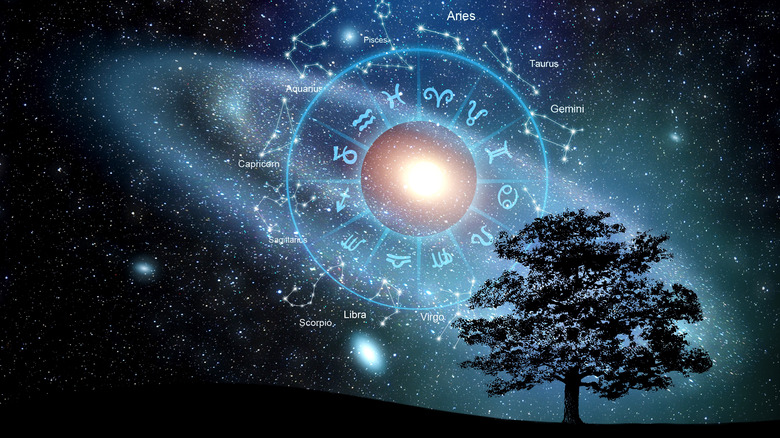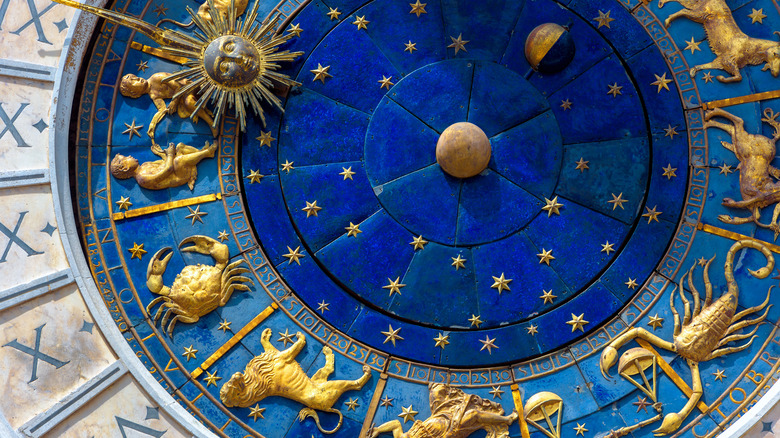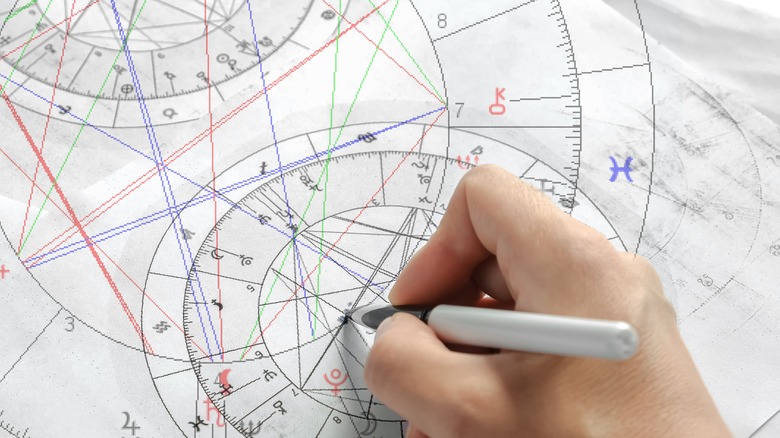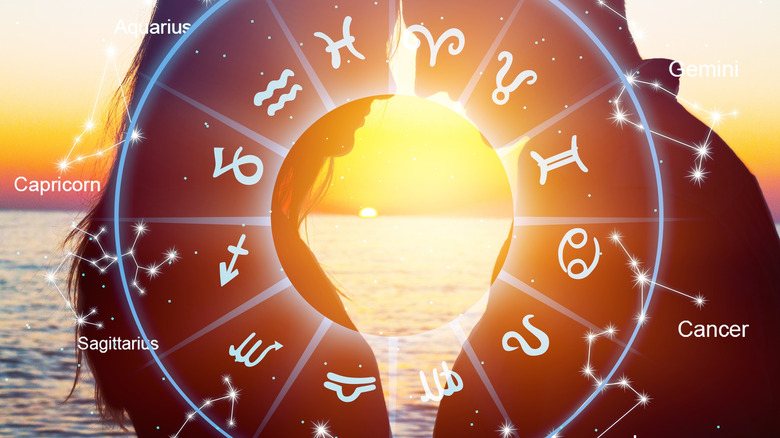Here's How To Read A Birth Chart
In the West, when many folks think of astrology or horoscopes (predictions based on astrology), they're probably thinking about "sun signs." You know, those little symbols, often animals, associated with birth months: Aries the bull (March 21–April 19), Cancer the crab (June 21–July 22), and the like. As some people believe, somehow, some way, these symbols associate with the constellations, when you were born, and bingo-presto: It's best that you listen to your instincts and stay in this Saturday rather than waste your energy getting to know that new person at work.
Of course, it's ridiculous to think that 8 billion living humans could be reduced to 12 simplistic archetypes. Astrology, as a tradition originating in India, is way, way, way (several more "ways" are okay) more complex than sun sign horoscopes. It's so vast that you can go to astrology colleges like those on College Dekho and study it like an art. We've got sun signs, moon signs, ascendants, signs in houses (aspects of personalities), transits (temporary influences), prograde vs. retrograde movement (forwards vs. backwards spin), aspects (connections between signs), synastries (concurrences between people), and much more.
The most important part of astrological investigation is your birth chart (Astromatrix is a good resource for this). This is essentially a detailed portrait of "you" at the moment you were born. Day, hour, even the minute: It's all critical to evaluating your psyche, hang-ups, drives and desires, pathways to happiness, and so on.
Sun sign, moon sign, and ascendant
In traditional circles, astrology is considered an art. That means different interpretations are possible, and everything is flexible enough for folks to investigate and make determinations on a case-by-case basis. Birth charts are toolboxes full of stellar compasses, magnifying lenses, rulers, screwdrivers, and maybe even a crowbar or two. They're not laws, creeds, or immutable, rigid doctrines.
The top three most important pieces of a birth chart are sun signs, moon signs, and ascendants. Each sign refers to the locations of certain celestial bodies at the moment you were born. Sun signs answer the question, "What constellation was hanging out behind the sun at my birth?" Moon signs answer the same question for the moon. Ascendants ask the question, "What constellation was at the furthest point along the horizon at my birth?"
You can maybe see the symbolic relevance of each of these signs. The sun, big and bright, represents what you consciously want out of life. It's your stable, consistent personality or "self" (per Live About). The moon, dimmer and sheltered, represents unconscious drivers — needs that motivate us in deep, deep ways (per Independent). The ascendant represents the self that you put out in the world — your "vibe." It likewise represents the direction (like toward the horizon) that someone should take to grow as a person (per Well and Good). All possible combinations of interactions between these three key signs help compose an individual.
Aspects between planets
Next up: planetary aspects. Just to be clear, we're not going to list the meanings of all possible combinations of aspects. Feel free to investigate at your own leisure; there's about a quadrillion resources available on- and offline (but be discretionary about sources).
The New York Post has a good summary of aspects. Each planet — Mercury, Mars, Jupiter, and the rest — represents a different aspect of one's personality. For example, Venus represents love (go figure), Mercury represents communication style (think of the wing-footed god Mercury, aka Hermes, who delivered messages between gods), and Jupiter represents growth, expansion, fortune, all that good stuff (Jupiter is the Roman name for Zeus, king of the gods of Mt. Olympus). Just like sun and moon signs, your birth chart shows you which constellation was behind which planet at the moment of your birth. Astrologers sometimes regard inner, faster moving planets as more relevant to an individual because they move quickly. Outer, slower moving planets can encompass entire batches of people born over longer periods of time.
More pointedly, as Well and Good explains, all these planets, plus the sun, moon, ascendant and more, all interconnect in myriad ways. Think of your birth chart as a wheel crisscrossed by spokes. Conjunctions, sextiles, and trines are considered favorable "shapes," geometrically, between signs. Squares, oppositions, semi-sextiles, and others are considered unfavorable. All together, these can describe any and every aspect of your inner world, ideal career choices, romantic and non-romantic relationships, and so forth.
Planetary spin, transits, synastries, and more
Time to go one level deeper and cover a bunch of "miscellaneous" birth chart things, starting with prograde vs. retrograde spin. All planets in our solar system revolve counterclockwise around the sun. All planets also rotate counterclockwise on their individuals axes, except for Venus and Uranus (as Science Direct explains). Why? We don't know. Presumably, some passing interstellar body in the distant past messed with their rotations.
"Prograde" refers to a planet spinning in its typical direction, in which case its aspect strengthens you (like prograde Mars meaning "a real go-getter"). "Retrograde" refers to a planet spinning opposite to its typical direction, in which case its aspect hinders you (like retrograde Mars meaning a weak-willed person). Of course we don't mean that planets actually start spinning in the opposite direction. From Earth, looking south, planets temporarily look like they're headed in the opposite direction when the velocity of Earth makes our planet overcome their position in the sky, as Stars at Night describes.
Transits are easy enough to understand. As Refinery29 explains, they're temporary aspects caused by such-and-such planetary movement. A transit of Mercury (communication) through Venus (love), for instance, inclines someone to relate to their romantic interest through chit-chat and verbal communication. Transits also reflect in birth charts.
Finally, this birth chart primer should mention synastry, which often means "romantic compatibility." Just imagine the entire, webbed interaction of your birth chart and someone else's. If things mesh well, you're good to go.



